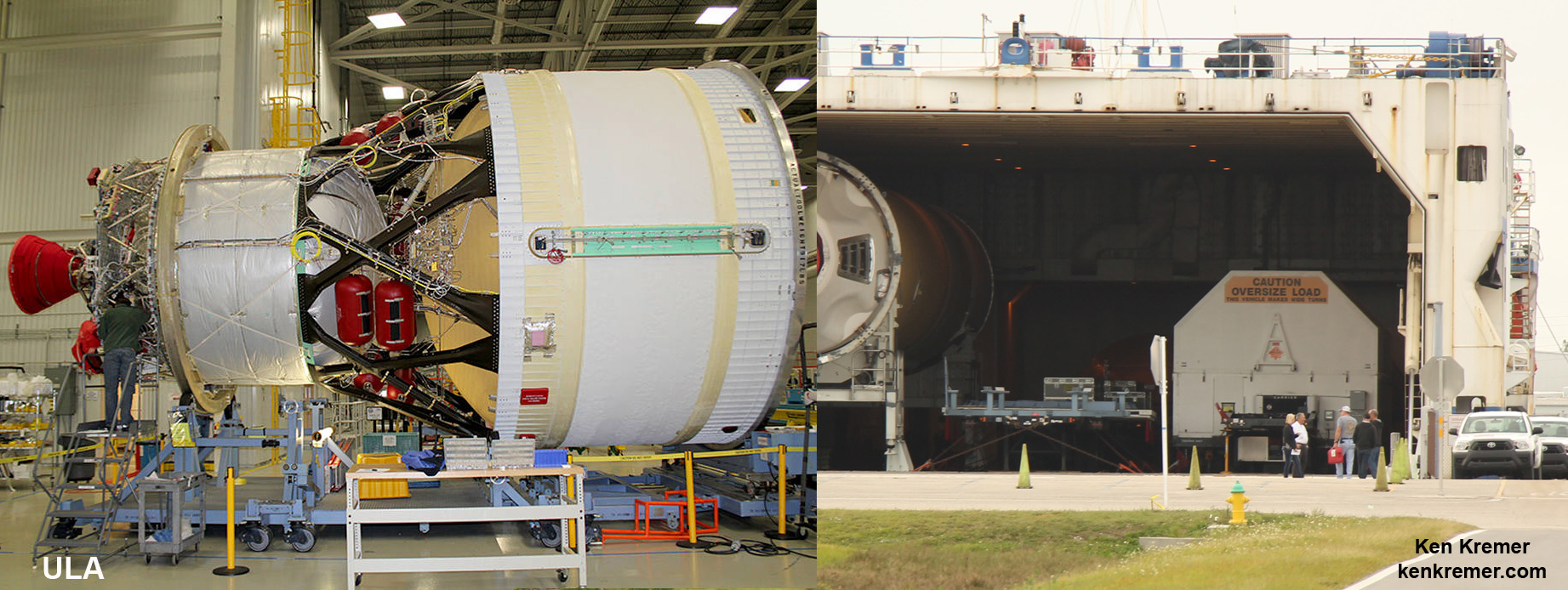
Composite view of the interim cryogenic propulsion stage (ICPS) for first flight of NASA's Space Launch System (SLS) rocket at United Launch Alliance manufacturing facility in Decatur, Alabama in December 2016 (left) and arrival of ICPS in a canister aboard the firm's Delta Mariner barge on March 7, 2017 (right). Credits: ULA (left) and Ken Kremer/kenkremer.com (right)
PORT CANAVERAL - Bit by bit, piece by piece, the first of NASA's SLS megarockets designed to propel American astronauts on deep space missions back to the Moon and beyond to Mars is at last coming together on the Florida Space Coast. And the first big integrated piece of actual flight hardware - the powerful second stage named the Interim Cryogenic Propulsion Stage (ICPS) - has just arrived by way of barge today (Mar. 7) at Port Canaveral, Fl.
The ICPS will propel NASA's new Orion crew capsule on its maiden uncrewed mission around the Moon - currently slated for blastoff on the maiden SLS monster rocket on the Exploration Mission-1 (EM-1) mission late next year.
SLS-1/Orion EM-1 will launch from pad 39B at NASA's Kennedy Space Center in late 2018. The SLS will be the most powerful rocket in world history.
NASA is currently evaluating whether to add a crew of 2 astronauts to the SLS-1 launch which would results in postponing the inaugural liftoff into 2019 - as I reported here.
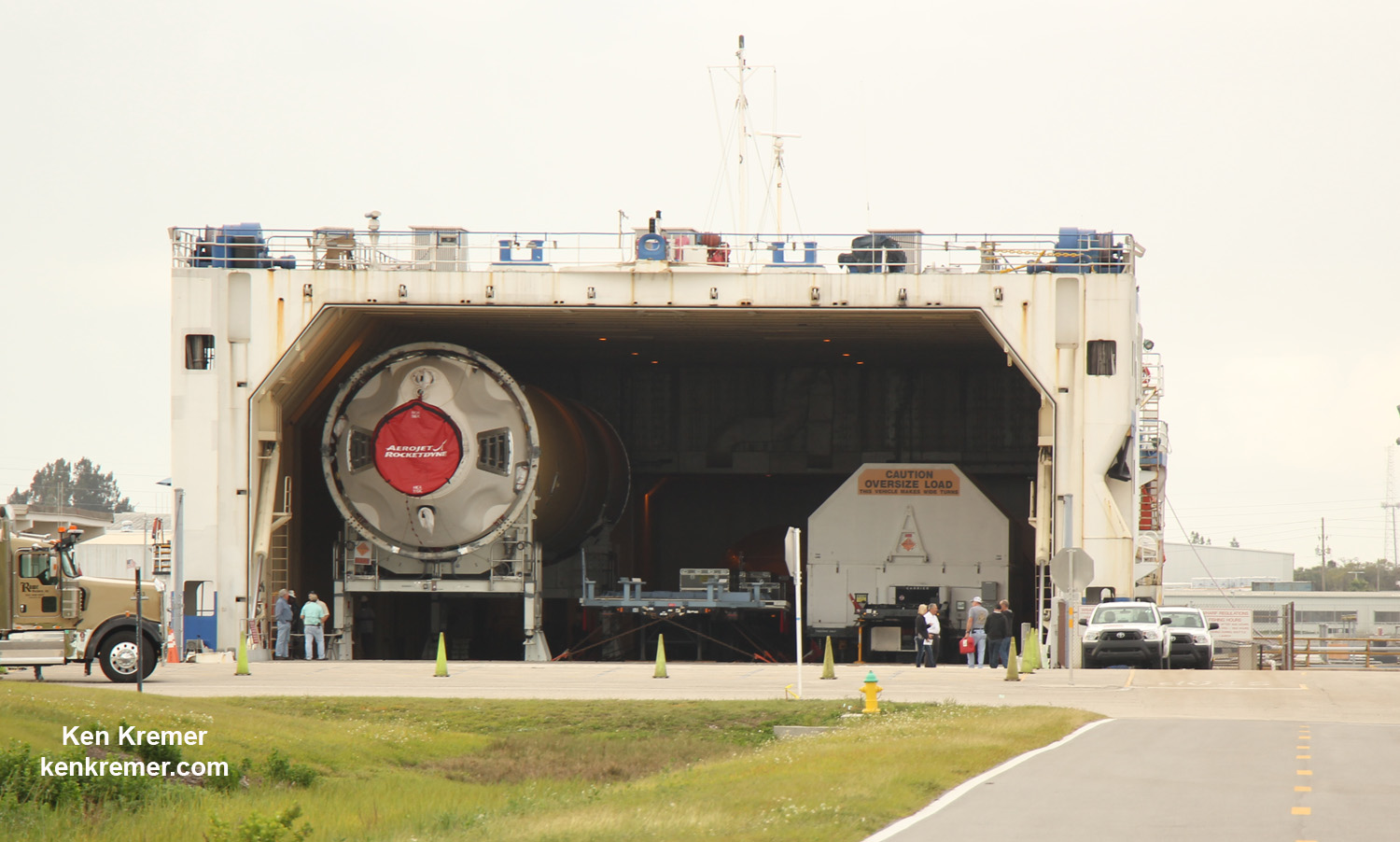
The interim cryogenic propulsion stage (ICPS) for first flight of NASA's Space Launch System (SLS) rocket arrived at Port Canaveral, Florida on March 7, 2017 loaded inside a shipping canister (right) aboard the ULA Delta Mariner barge that set sail from Decatur, Alabama a week ago. The ICPS shared the shipping voyage along with a ULA Delta IV first stage rocket core seen at left. Credit: Ken Kremer/kenkremer.com
The SLS upper stage - designed and built by United Launch Alliance (ULA) and Boeing - arrived safely by way of the specially-designed ship called the Delta Mariner early Tuesday morning, Mar. 7, into the channel of Port Canaveral, Florida - as witnessed by this author.
"We are proud to be working with The Boeing Company and NASA to further deep space exploration!" ULA said in a statement.
Major assembly of the ICPS was completed at ULA's Decatur, Alabama, manufacturing facility in December 2016.
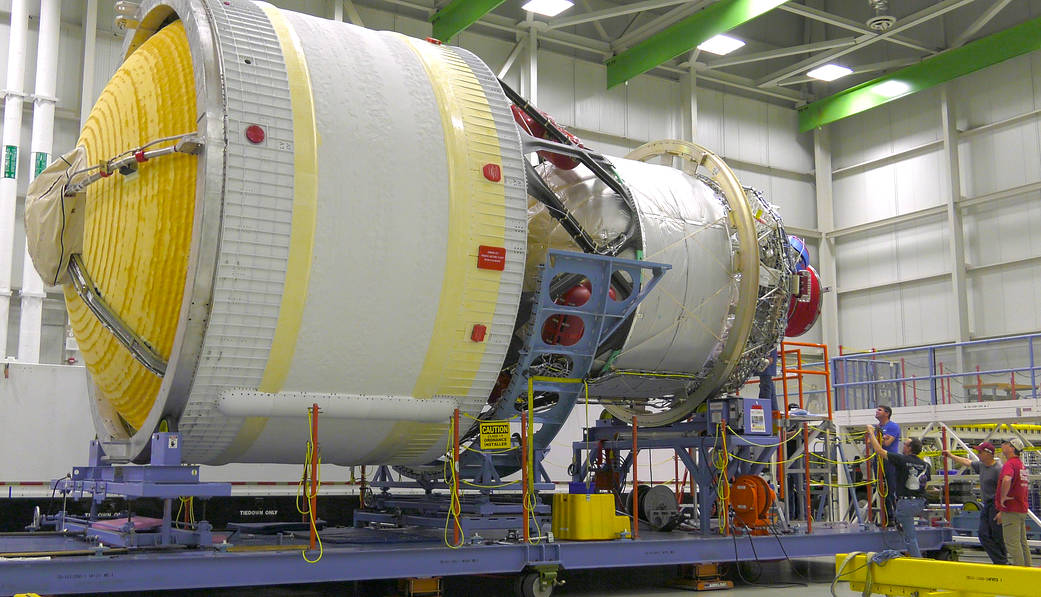
The interim cryogenic propulsion stage (ICPS) for the first flight of NASA's Space Launch System (SLS) rocket has arrived by way of barge at Cape Canaveral Air Force Station in Florida on March 7, 2017. The ICPS will be moved to United Launch Alliance's Delta IV Operation Center at the Cape for processing for the SLS-1/Orion EM-1 launch currently slated for late 2018 launch from pad 39B at NASA's Kennedy Space Center. Credit: ULA
The ICPS is the designated upper stage for the first maiden launch of the initial Block 1 version of the SLS.
It is based on ULA's Delta Cryogenic Second Stage which has successfully flown numerous times on the firm's Delta IV family of rockets.

The ULA Delta Mariner barge arriving in Port Canaveral, Florida on March 7, 2017 after transporting the interim cryogenic propulsion stage (ICPS) hardware for the first flight of NASA's Space Launch System (SLS) rocket from Decatur, Alabama. SLS-1 launch from the Kennedy Space Center is slated for late 2018. Credit: Ken Kremer/kenkremer.com
The ICPS was loaded onto the Delta Mariner and departed Decatur last week to began its sea going voyage of more than 2,100 miles (3300 km). The barge trip normally takes 8 to 10 days.
"ULA has completed production on the interim cryogenic propulsion stage (ICPS) flight hardware for NASA's Space Launch System and it's on the way to Cape Canaveral aboard the Mariner," ULA noted in a statement last week.
The 312-foot-long (95-meter-long) ULA ship docked Tuesday morning at the wharf at Port Canaveral to prepare for off loading from the roll-on, roll-off vessel.
The Delta Mariner can travel on both rivers and open seas and navigate in waters as shallow as nine feet.
"ICPS, the first integrated SLS hardware to arrive at the Cape, will provide in-space propulsion for the SLS rocket on its Exploration Mission-1 (EM-1) mission," according to ULA.
The next step for the upper stage is ground transport to United Launch Alliance's Delta IV Operation Center on Cape Canaveral Air Force Station in Florida for further testing and processing before being moved to the Kennedy Space Center.
ULA will deliver the ICPS to NASA in mid-2017.
"It will be the first integrated piece of SLS hardware to arrive at the Cape and undergo final processing and testing before being moved to Ground Systems Development Operations at NASA's Kennedy Space Center," said NASA officials.
"The ICPS is a liquid oxygen/liquid hydrogen-based system that will provide the thrust needed to send the Orion spacecraft and 13 secondary payloads beyond the moon before Orion returns to Earth."
The upper stage is powered by a single RL-10B-2 engine fueled by liquid hydrogen and oxygen and generates 24,750 pounds of thrust. It measures 44 ft 11 in (13.7 m ) in length and 16 ft 5 in (5 m) in width.
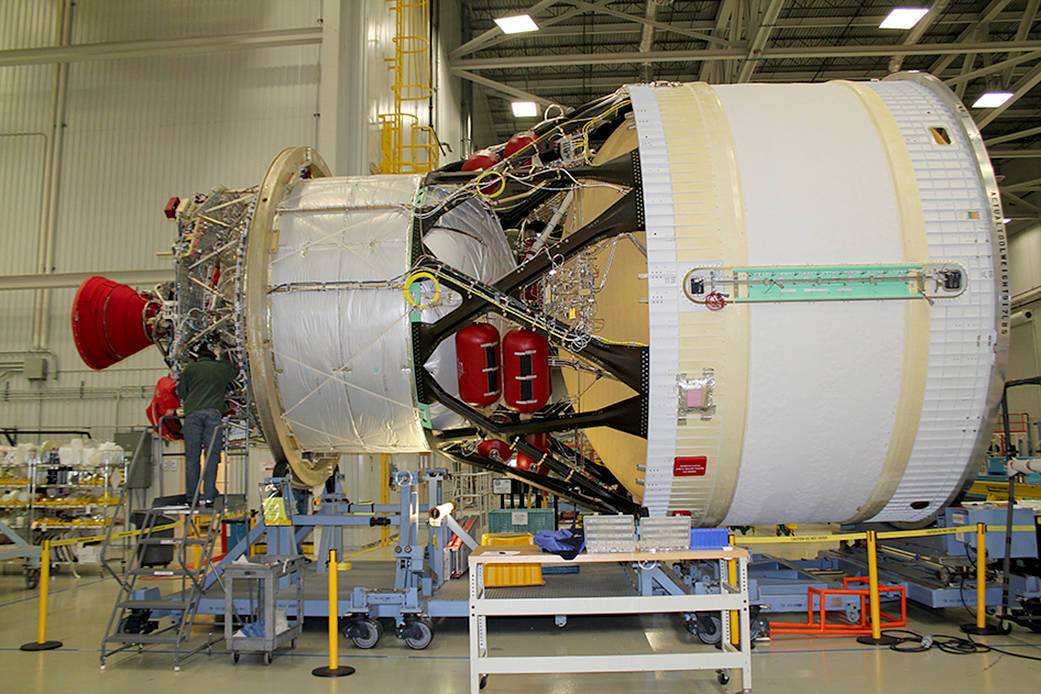
The interim cryogenic propulsion stage (ICPS) for the first flight of NASA's Space Launch System (SLS) rocket as it completed major assembly at United Launch Alliance in Decatur, Alabama in December 2016. The ICPS just arrived by way of barge at Cape Canaveral Air Force Station in Florida on March 7, 2017. It will propel the Orion EM-1 crew module around the Moon. The SLS-1/Orion EM-1 launch is currently slated for late 2018 launch from NASA's Kennedy Space Center. Credit: ULA
All major elements of the SLS will be assembled for flight inside the high bay of NASA's iconic Vehicle Assembly Building which is undergoing a major overhaul to accommodate the SLS. The VAB high bay was extensively refurbished to convert it from Space Shuttle to SLS assembly and launch operations.
For SLS-1 the mammoth booster will launch in its initial 70-metric-ton (77-ton) Block 1 configuration with a liftoff thrust of 8.4 million pounds - more powerful than NASA's Saturn V moon landing rocket.
The next Delta IV rocket launching with a Delta Cryogenic Second Stage is tentatively slated for March 14 from pad 37 at the Cape.
Stay tuned here for Ken's continuing Earth and Planetary science and human spaceflight news.
Ken Kremer
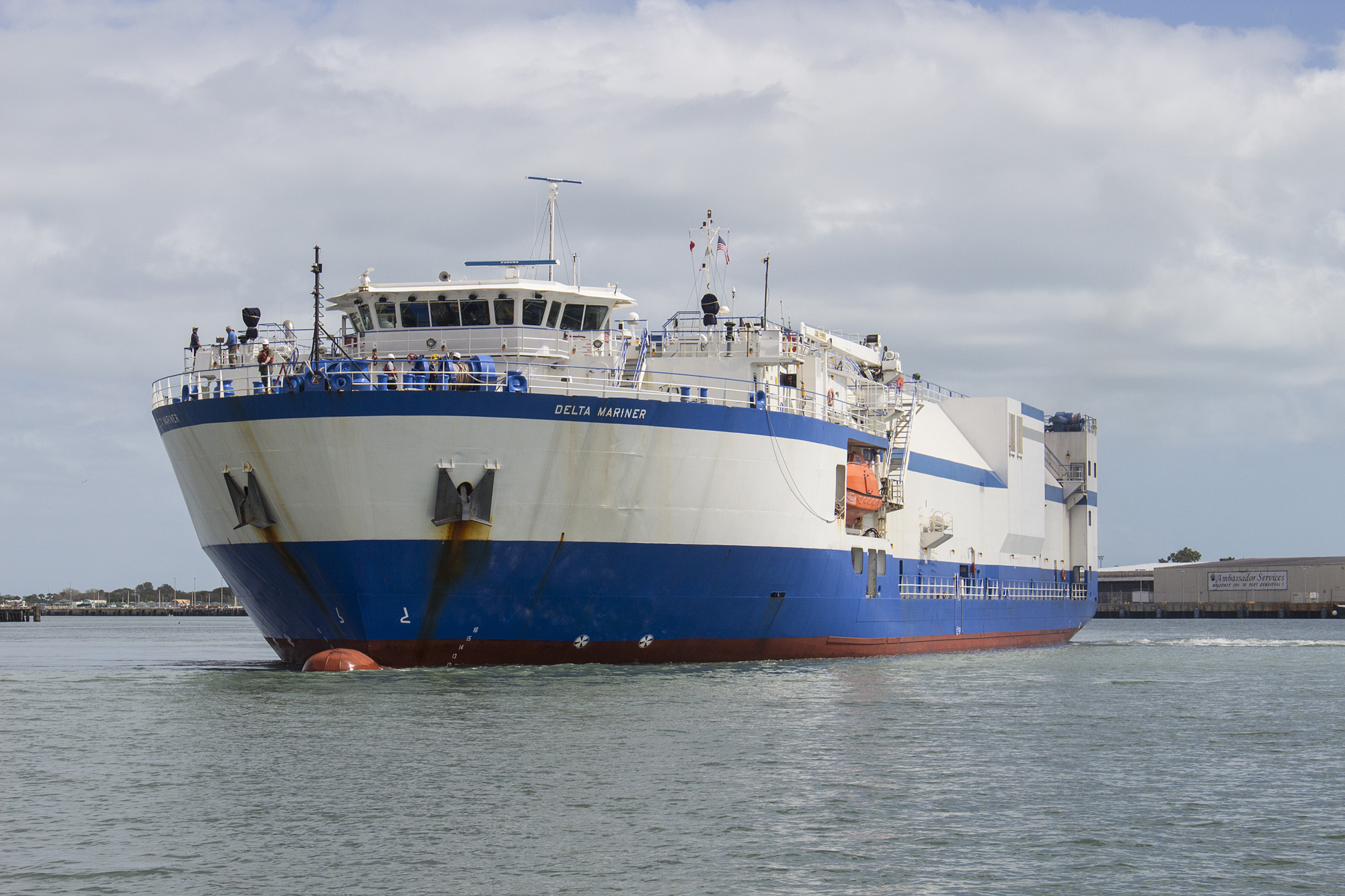
File photo of the ULA Delta Mariner barge arriving in Port Canaveral, Florida after transporting rocket hardware from Decatur, Alabama
No comments:
Post a Comment